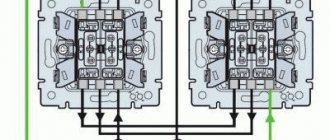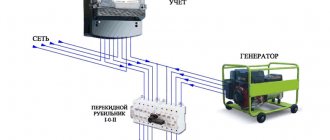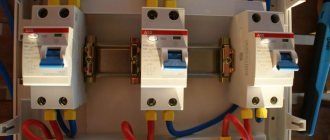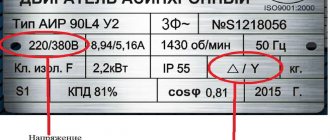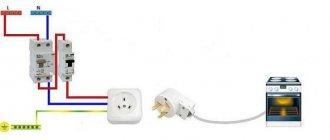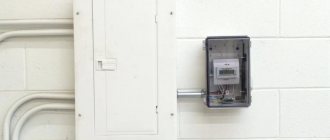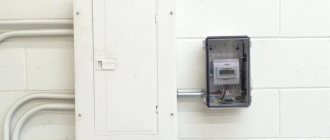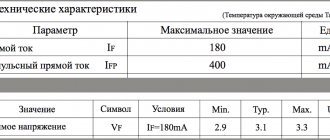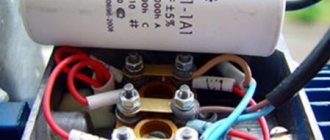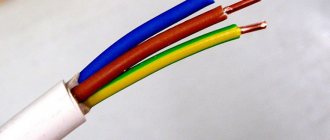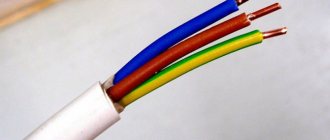A gasoline generator or its diesel analogue, at their low cost, is the most suitable source of emergency power supply for a private home or cottage. Such installations are easy to transport and operate . The electrical installation of a gas generator, as well as its selection, requires a responsible approach. Incorrect connections can cause damage to household appliances or short-circuit wires in the house, not to mention it poses a danger to life. But if you know how to connect a gas generator to the home network correctly, you can restore the operation of electrical appliances quickly and safely.
How can you not do it?
When connecting a gas generator to the house, you cannot connect it to any nearby outlet without turning off the circuit breakers on the switchboard in advance.
The power of the generator can be much greater than the capacity of the outlet (usually the latter is designed for 3500 W). The result is a short circuit due to exceeding the maximum load, and a fire.
If at the same time you do not turn off the main line circuit breakers, then supplying energy to the network will lead to a breakdown of the generator.
Connecting home power through an outlet is only allowed for low-power (up to 4 kW) installations. But even in this case, it is better to connect electrical appliances to the generator via an extension cord. For powerful stations it is necessary to use an autostart system - AVR or a reversing switch.
Emergency connection
There are situations when there is no time for preparatory work to integrate an autonomous generator into the household electrical network, and you need to use electrical appliances urgently. There are several ways to “fire” connect a generator to the network of a country house.
Connection directly via socket
This method of connecting a power source to the network is the fastest and easiest. It only requires the purchase or self-production of a special extension cord with plug ends. Naturally, manufacturers of devices for autonomous generation of electric current strongly do not recommend this method of introducing generators into the power grid, but its simplicity is attractive, and, as a rule, owners of such equipment with low and medium power quite often use such a connection in emergency cases.
The idea of this method is quite simple: if, with a parallel connection of all consumers in the home network, you supply “phase” and “zero” to one of the sockets, then voltage will appear in other sockets.
But such a simple scheme for connecting a gas generator to a home network also has its drawbacks, which must be taken into account in order to avoid troubles during operation. There are few of them:
- Excessive load on the wire.
- The need to turn off the input machine.
- Application of protection devices.
- Inability to monitor the restoration of power from the regular power line.
Paying attention to these points will prevent damage to the generating device and ensure the safety of its use.
Upon closer examination of such a nuance as wiring overload, it can be noted that when using generators with a power of up to 3 thousand W, this point can be neglected, since the standard socket wiring has a cross-section of 2.5 mm square, and the sockets are designed for a current of 16 A According to the characteristics of such wiring, it can withstand power consumption up to 3.5 kW. When using more powerful devices for generating electric current, you should ensure that the total power consumption of the switched on devices does not exceed 3500 W. Otherwise, overheating and wiring failure will occur.
When connecting a gasoline (or diesel) generator through an outlet to the electrical network, it is necessary to disconnect it from the external network. This is done by turning off the machines at the entrance. Otherwise, the electric current generated by autogenerators will go to the neighbors. And under increased load the device will simply stall. But if current is supplied from the main line, then this situation is guaranteed to lead to a burned-out generator winding.
You might be interested in Autonomous solar power plants for the home
When home wiring is installed in accordance with the requirements of the PUE, the outlet lines are additionally protected by RCDs (residual current devices). The nuances are that when connecting a gas generator to the network, it is necessary not only not to reverse the polarity (phase-zero), but also in some RCDs the power source is connected to the upper terminals, and the load to the lower ones. If the autogenerator is connected incorrectly, the system will turn off , and redoing the entire power supply circuit for the sake of several hours of operation from an autonomous power plant is a rather labor-intensive and time-consuming task.
Socket “powering” of a home or country electrical network is also inconvenient due to the inability to track the appearance of potential differences in the main network in order to switch from autonomous power to an external source in time.
Integration via distribution machine
The optimal option for connecting a generator to the home network is considered to be connection through a current distribution machine. But even with this switching method, you need to pay attention to a number of points in order to avoid unnecessary troubles when operating the generator.
The easiest way to connect a gas generator to the home network is to integrate it into the electrical network using a socket mounted next to the distribution machine and schematically located after the electric meter, but in front of the distribution machine. Such sockets remain energized when the distribution machine is turned off, but the input machine is turned on.
If you need to supply power to your home network from an autonomous source, then the input machine is turned off and the device for generating current is connected to the outlet. In this option, the load limitation rests solely on the throughput characteristics of this outlet (usually 16 amperes).
The absence of such an outlet in the home wiring will make it a little more difficult to connect through a switchboard. You just need to remove the standard input wiring from the distributor, and in its place connect the “phase” and “zero” from the autogenerator. And, if there is an RCD in the wiring, you need to maintain the polarity when connecting.
When the input wiring of the main line is disconnected from the switchboard of the home network, it becomes possible not to turn off the input circuit breaker, but to attach a test lamp to the free ends of the disconnected wires. When power is supplied from the power line, it will light up, signaling the need to switch from an autonomous source to an external power supply to the network.
Basic connection tasks
When installing electrical installations, the following indicators must be taken into account :
- need for automation;
- location in terms of efficiency and safety;
- stock selection;
- frequency of network outages;
- power consumption taking into account losses.
It is important to create a suitable connection diagram for a gasoline generator.
Automation of the process is expensive and requires qualified maintenance. Manual connection for a private home is the most gentle mode. Such switches are produced in two types: a changeover type switch (old model) or a reversible switch (three-way). You can find out more about them below. They also use partial automation, because semi-automatic machines are inexpensive. Regardless of the chosen method, you need to monitor the operation of the system.
How to choose the right three-phase generator
When choosing branded units, you will have to take into account the following characteristics:
- type of energy carrier;
- device output power;
- availability of additional functions.
The type of fuel is selected taking into account specific operating conditions (convenience of storing fuel in a residential building). The output power of the purchased unit is selected taking into account the expected load; this figure varies from 5 to 6 kW for each single-phase branch. When getting acquainted with additional functionality, special attention is paid to the following features:
- adjustment of 3-phase voltage parameters (its shape, in particular);
- possibility of connecting additional lines (load capacity);
- the presence of an electromagnetic relay-regulator.
It is important to make sure that the selected model has indicator devices that allow you to visually monitor the level of each voltage.
Where should the station be located?
The room should be dry , with good ventilation. In addition, a very unpleasant hum emanates from the generator during operation. Taking these nuances into account, it is better to install and connect the electrical installation in a garage, outbuilding or under a canopy.
The electric generator is installed on a foundation that does not have a rigid connection with the building. You can place the device on special shock absorbers or on a rubber cushion. This helps reduce the sound of the generator.
Installing special noise-protective enclosures also helps reduce the hum.
Instructions for connecting to the network
After choosing the appropriate connection method, you can begin electrical installation .
The easiest way is to connect the devices to the generator outlet. No additional manipulations are required in this option. But to connect a powerful gas generator to the house, this method will not work. Here you need to follow the following instructions:
- We ground the electrical installation.
- We provide separate input. We carry it out with a high-section copper cable (at least 4 mm2) and stretch it from the distribution panel to the installation site of the gas generator.
- We install a changeover switch or a three-way switch next to the panel in order to connect the gas generator.
You can connect the generator using a semi-automatic system or ATS - you can read about this below.
How to connect a generator to a three-phase network at home?
- How to connect a single-phase generator?
- Auto switching circuit
- Via socket
- Important Rules
A backup source of electrical energy will never be superfluous in a country house in case of emergency. Unplanned, permanent or accident-related power outages can negatively impact electrical appliances. And when your heating system is dependent on the supply of electricity, then in winter there is a danger that the home will cool down and its owner will freeze.
I didn’t want to connect the generator through the ATS circuit, because I don’t have the knowledge or funds for this, but I decided to do everything myself and connect it without automation.
The store advised me to connect the generator directly through the outlet, but I did not do so for safety reasons. And they offered and sold me this adapter:
Cable with plugs for connecting the generator to an outlet
To make using the generator safer, I made the following socket for it on the wall of the summer kitchen:
Generator socket
The SSI-114 type socket has a cover that protects live parts. But there will always be voltage on it - both when the generator is running and from the street! I secured it higher so that the children couldn’t reach it.
I made another adapter for connection so as not to confuse it with anything else, and signed the danger warnings.
Connection cable
The fork looks like this:
Generator output plug
This is the most dangerous place in the structure. But how to avoid trouble is the secret in the connection sequence, more on that later.
Connection diagrams
There are three wires coming from them. The generator network is connected to one, the utility network is connected to the other, and electrical equipment is connected to the third. Power from the mains is connected to the switch at the top, and a wire from the gas generator at the bottom. Electricity consumers are connected to the middle contacts. The switch is installed after the meter, but before the input machines. You can use a semi-automatic connection scheme. After turning off the central power supply, you need to start the device. An additionally installed time relay turns on the gas generator contactor after the engine warms up.
When the main power supply appears, it will switch to it, and an additional relay will stop the generator.
Automatic connection is even easier . The AVR system autonomously starts a backup energy source when the city network is turned off. The block is connected to the distribution panel. The connection to the gas generator is made by cable.
In addition to the use of automatic transfer switches, it is possible to use the following devices: voltage stabilizer, inverter, UPS.
Possible mistakes
In addition to connecting a powerful power station to an outlet, the home owner is capable of making the following mistakes:
- Install the unit in a windproof basement, which can lead to overheating and concentration of toxic exhaust gases.
- Place the generator outdoors – the device can be damaged by snow or rain.
- Do not make grounding.
- Incorrect input cable cross-section.
- Perform switching of a switch or reversing device under load.
All these errors can cause a short circuit in the generator circuit with unpredictable consequences.
Generator autostart
Connecting the power plant to the home network through an autostart system - AVR - simplifies connecting the home to a backup power source. The system is equipped with an electric starter. The automatic start device controls the main network immediately after power is applied to it. The transfer to the backup power supply of the home network with automatic transfer switch occurs 10 seconds after the loss of voltage in the city main. Then the external network is turned off and the gas generator starts. After the engine warms up for 20 seconds, the installation is connected to the home network.
When voltage appears in the citywide main line, the source is switched off, and the home network begins to operate in standard mode.
Then the electric generator motor is turned off.
Correctly connecting the generator to the house: connection steps
If you live in your own home, then you definitely could use an additional source of energy. Today, additional sources include electric generators. Turning off the lights can sometimes negatively affect the operation of your equipment. This is why many people have switched to using generators.
Buying a generator for yourself will not solve the situation. You will also need to connect the generator to the house. This is a rather labor-intensive process, but you can solve it yourself. Thanks to this article, you will learn how to connect a generator to your home.
Connecting the generator to the house
The connection diagram for the generator to the home network can be of two types. Having studied these two methods, you will be able to connect the generator yourself. In this case, you can significantly save your money on calling a specialist. These are the methods:
- Method with changeover switches.
- Using automatic control.
Connecting a generator with a changeover switch
When using this method, you can use two types of switches: changeover or reverse. The reverse switch has three types of transition. With their help, you can switch your home network to different power sources. Three branches can be connected to each type of switch:
- From the main network to your generator.
- From home to device.
- From generator to device.
Electric generators have a fairly simple operating principle. It will work when the main network is turned off. If the current supply returns to normal, then the generator will stop working. Only one source should be active in your home.
When connecting a generator, it is best to use a copper cable. Here is the mounting diagram for the contacts:
- Its upper contacts must be attached to the main network.
- The middle contacts will be responsible for the private circuit of the house.
- Bottom contacts are usually intended for power plants.
This contact diagram may also be useful to you when connecting an air conditioner.
Here are the main steps to start the generator:
- First, you need to warm up the device for a few minutes.
- After this, the switch must be turned down.
Connecting a generator with automatic start
Connecting the generator to the power grid can be automated. Today, many devices have this function. When the lights in your home go out, the system will automatically start the device into operation. When power returns, the device will turn off.
These devices have a fairly simple operating principle. It consists of:
- ATS systems that are connected to the electrical network.
- The main control cable must connect the ATS and the generator.
- A cable should come out of it, which will be attached to the contacts of the generator.
Safety rules when using a power plant
Connecting a generator in a private home involves following certain rules. By following these rules, you can ensure your reliable protection and safety:
- If the station is located indoors, then it should be well ventilated. If the device has more power, then it is better to place it outside.
- The station must be completely protected from bad weather.
- When connecting contacts, do not leave unprotected areas.
- The generator should not be exposed to high temperatures.
- Devices must be grounded.
How to ground a generator?
In order for your home power plant to have a good grounding, you may need a metal rod, tube and galvanized iron. These are the basic materials you will need. The pipes that need to be placed in the ground will provide reliable grounding for your device. It is necessary that the tube is constantly wet. Connecting an electric boiler also requires proper grounding.
Using a changeover switch
When the input circuit breaker is turned off, the changeover switch connects power from the power plant . This happens in stages:
- Disabling circuit breakers.
- Connecting the switch wire to the generator.
- Starting and warming up the generator.
- Supplying power to the switch.
- Switching on automatic load switches.
When electricity appears in the main network, the generator is turned off, performing the above steps in reverse order.
Types of generators
Based on the type of fuel used in the unit, all known generating devices can be:
- gasoline;
- diesel;
- units running on gas or wood.
The first two options attract the attention of users who have taken as a basis a ready-made engine running on gasoline or diesel fuel.
Gas and wood burning devices are less efficient when used in the home and are used extremely rarely.
According to their purpose, known samples of three-phase current generators are divided into main and backup units. The question of how to connect to a household network concerns both models.
Application of ABP
The autostart system is more expensive than the manual one , but it constantly monitors the network voltage. When the voltage disappears, the contactor interrupts the connection between the ATS and the central power grid. The starter turns on and the generator starts working. Most generator owners prefer using cheaper partial automation, which works as follows:
- The main power supply is connected through a contactor that opens when the input is disconnected.
- The gas generator is started manually. A time relay is installed in it to warm up the engine and automatically switch to connecting the reserve to the home network.
- When the power supply is restored, the contactor is switched off and the load is supplied again from the public network.
A fully automated power supply system regulates the operation of the gas generator using microprocessors. Video on this topic
Installation of the ground loop
To ground the electric generator yourself, you will need a copper wire , a metal rod 150 cm long and 1.5 cm in cross-section. The rod is driven almost its entire length into the soil. A special clamp or a regular bolt is welded to it for easier connection of the ground wire. The copper cable runs from the rod to the appropriate terminal on the backup source.
Or, an iron sheet measuring 0.5x1 m is used as a grounding conductor. The grounding conductor is buried in the ground and connected to the unit with a wire using clamps.
With a three-phase power supply in the house, experts advise making a backup of only one phase for connection to a gas generator. It will power the necessary equipment: refrigerator, lighting, computer.
Phase imbalance in a three-phase connection is a common occurrence, and it can damage the electrical wiring of the house.
If, even after reading the instruction manual, you do not know how to safely connect a gas generator to the network at home, you should seek help from specialists.
